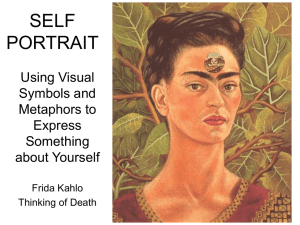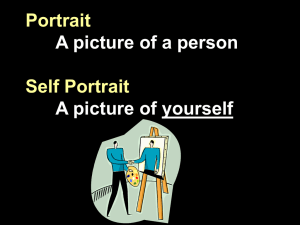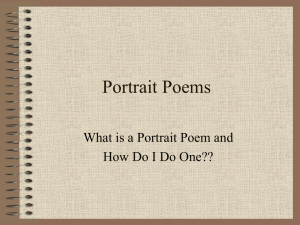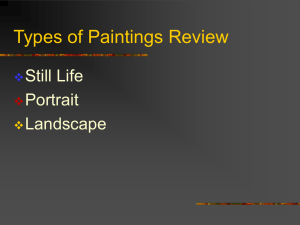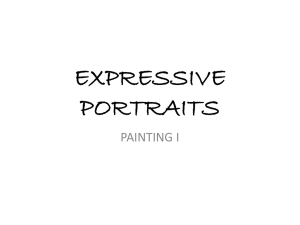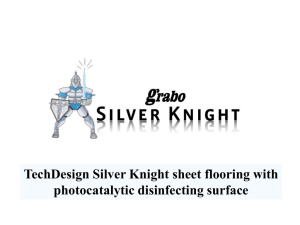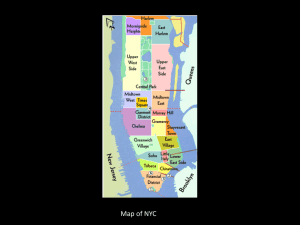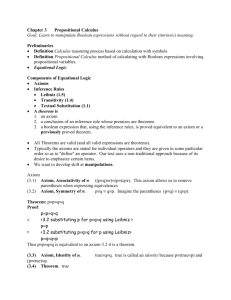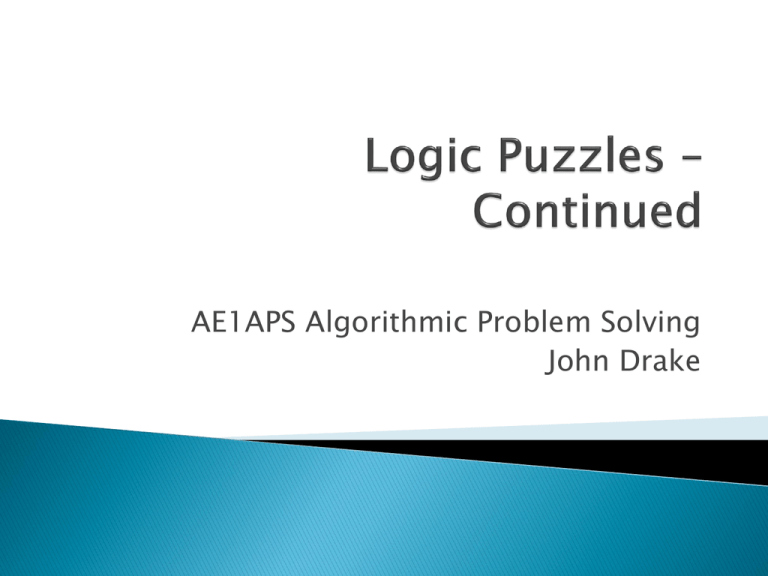
AE1APS Algorithmic Problem Solving
John Drake
Invariants – Chapter 2
River Crossing – Chapter 3
Logic Puzzles – Chapter 5 (13)
◦ Knights and Knaves
◦ Portia’s Casket
Matchstick Games - Chapter 4
Sum Games – Chapter 4
Induction – Chapter 6
Tower of Hanoi – Chapter 8
Conjunction: X ∧ Y (AND)
Disjunction: X ∨ Y (OR)
Negation (or complement): ¬X (NOT)
Inequivalence: ≢ (DIFFERENT)
Implication: X ⇒ Y, (X implies Y)
Boolean expressions are either true or false.
Boolean valued expressions are called
propositions.
“it is sunny” is an atomic Boolean expression.
“it is sunny and warm” is non atomic as it can
be broken down into two expressions.
We are concerned with the rules for
manipulating Boolean expressions.
= or ≡ ?
In which order should x = y = z be
processed?
As an example, if x = true, y = false and z =
false.
If read continually - true = false = false
evaluates to false
However if read associatively –
(x = y) = z or x = (y = z)
it will evaluate to true
To remove this confusion we use ≡ to
indicate that an expression should be
considered associatively.
The property of associativity is very powerful!
Negation: [¬ x ≡ x ≡ false] p.106
Inequivalance: x ≢ y or ¬(x ≡ y) p.113
[¬(x ≡ y) ≡ x ≡ ¬y ]
Equality is a binary relation.
It is a function with a range of Boolean values
true and false.
Equality is reflexive: [x ≡ x]
It is symmetric: [x ≡ y is the same as y ≡ x]
It is transitive: [x ≡ y and y ≡ z implies z ≡ x]
It is associative:
[(x ≡ y) ≡ z is the same as x ≡ (y ≡ z) ]
It is substitutive: [x ≡ (y ≡ z) can be replaced
by (y ≡ z) ≡ (y ≡ z) ]
Given a pair of natives, what question would
you ask one to discover if the other is a
knight?
I’m a
Knight
I’m a
Knight
If A is the proposition: “person A is a knight"
and suppose the native makes a statement S.
We can infer that A is true is the same as S is
true. That is,
A≡S
If native A is asked a yes/no question Q then
the response to the question is:
A≡Q
Let R be the desired response when we ask
question Q:
i.e. R ≡ (A ≡ Q)
R ≡ (A ≡ Q)
A – The statement “A is a knight”
Q – The response to a given question
R – The desired response from the native
R ≡ (A ≡ Q)
A – The statement “A is a knight”
◦ We can ask
Q – The response to a given question
◦ What we are trying to find
R – The desired response from the native
◦ “Is B a knight?” – we will call this proposition B
So, B ≡ (A ≡ Q)
A and B are statements,
Q is the question to be asked
As equality is associative
B ≡ (A ≡ Q) becomes (B ≡ A) ≡ Q
As equality is symmetric
(B ≡ A) ≡ Q becomes Q ≡ (A ≡ B)
So we ask the native is (A ≡ B)?
“Is the statement of your being a knight equivalent to
the statement of B being a knight”
In Shakespeare's Merchant of Venice, Portia
had three caskets: gold, silver and lead.
Inside one of these caskets Portia had put her
portrait and on each was an inscription.
Portia explained to her suitor that each
inscription could be either true or false but
on the basis of the inscriptions he was to
choose the casket containing the portrait.
If he succeeded he could marry her.
Here we will consider a simpler variant of this
problem using only two caskets
Suppose there are two caskets, gold and
silver, into one of which Portia placed her
portrait.
The inscriptions are:
◦ Gold: The portrait is not in here.
◦ Silver: Exactly one of these inscriptions is true.
Which casket contains the portrait?
Let pg stand for “the portrait is in the gold
casket“
Let ps stand for “the portrait is in the silver
casket“
Let ig stand for “the inscription on the gold
casket is true"
and let is stand for “the inscription on the
silver casket is true“
What do we know?
If the inscription on the gold casket is true then
the portrait is in the silver casket
i.e. ig ≡ ps
As there is only one portrait pg and ps cannot
both be true
i.e. pg ≢ ps
The inscriptions are:
Gold: The portrait is not in here.
Silver: Exactly one of these
inscriptions is true.
What do we know?
For one statement to be true ig ≡ ¬is
So for is to be true this condition must hold
i.e.
is ≡ (ig ≡ ¬is)
The inscriptions are:
Gold: The portrait is not in here.
Silver: Exactly one of these
inscriptions is true.
This leaves us with three statements to help
us decide which casket the portrait is in.
(ig ≡ ¬pg) ∧ (pg ≢ ps) ∧ (is ≡ ig ≡ ¬is)
The inscriptions are:
Gold: The portrait is not in here.
Silver: Exactly one of these
inscriptions is true.
(ig ≡ ps) ∧ (pg ≢ ps) ∧ (is ≡ ig ≡ ¬is)
Using the definition of negation and inequivalance
(ig ≡ ps) ∧ (pg ≡ ps ≡ false) ∧ (is ≡ ig ≡ is ≡ false)
Using reflexivity of equality [( is ≡ is) ≡ true]
(ig ≡ ps) ∧ (pg ≡ ps ≡ false) ∧ (ig ≡ false)
Equality is substitutive, then use reflexivity
(false ≡ ps) ∧ (pg ≡ true) ∧ (ig ≡ false)
What can we deduce?
ps is false
pg is true
ig is false
So the portrait is in the Gold casket
Note: we know nothing about the inscription
on the Silver casket
Please e-mail me with any questions or
problems you are having
Tutorial session this afternoon at 1pm
Hopefully extra slots start next week
John.drake@nottingham.edu.cn


